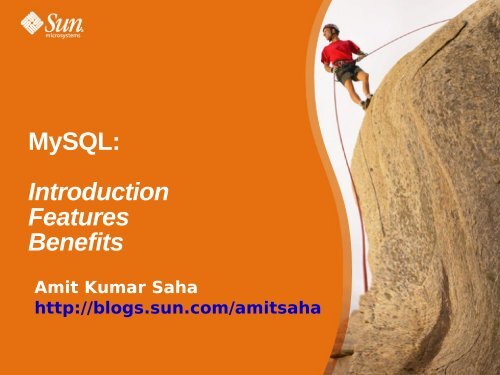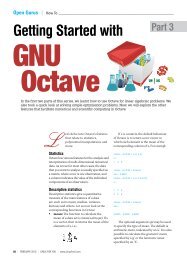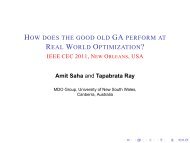MySQL: Introduction Features Benefits
MySQL: Introduction Features Benefits
MySQL: Introduction Features Benefits
You also want an ePaper? Increase the reach of your titles
YUMPU automatically turns print PDFs into web optimized ePapers that Google loves.
<strong>MySQL</strong>:<br />
<strong>Introduction</strong><br />
<strong>Features</strong><br />
<strong>Benefits</strong><br />
Amit Kumar Saha<br />
http://blogs.sun.com/amitsaha
<strong>Introduction</strong><br />
Relational Database Management<br />
System<br />
Outcome of Open Source and Free<br />
Software<br />
Free<br />
Widley used - Information<br />
Systems/embedded systems<br />
Primarily written in C/C++<br />
Available for Linux, Solaris, MS<br />
Everyone Windows and and Everything other Operating Participating on<br />
Systems the Network
<strong>Introduction</strong><br />
Client – Server architecture<br />
<strong>MySQL</strong> Server<br />
<strong>MySQL</strong> Client- command line, desktop<br />
applications, web applications
A bit of History<br />
Named after co-founder Monty<br />
Widenius's daughter, My<br />
mSQL- tweaks and hacks to form<br />
<strong>MySQL</strong><br />
<strong>MySQL</strong> AB, now a subsidiary of Sun<br />
Microsystems, which holds the copyright<br />
to most of the codebase<br />
“AB” part of the company name is the<br />
acronym for the Swedish “aktiebolag,” or<br />
“stock company”<br />
Everyone and Everything Participating on<br />
the Network
A bit of History<br />
The name of the <strong>MySQL</strong> Dolphin<br />
(<strong>MySQL</strong> logo) is “Sakila,” which was<br />
chosen by the founders of <strong>MySQL</strong> AB<br />
from a huge list of names suggested<br />
by users in their “Name the Dolphin”<br />
contest
<strong>MySQL</strong> <strong>Features</strong> and Architecture
<strong>MySQL</strong>: <strong>Features</strong><br />
Speed<br />
Multi-threaded architecture: Multiple<br />
clients have concurrent access<br />
Query Cache: Cache the results of<br />
common queries<br />
Reliability<br />
Ease of use<br />
Command line interface<br />
Graphical tools- Desktop/ Web based
<strong>MySQL</strong>: <strong>Features</strong><br />
Multi-User support<br />
Multiple clients have concurrent access to<br />
one (or more) databases simultaneously<br />
Powerful and flexible user privilige system<br />
User and host-based authentication<br />
schemes<br />
Scalability<br />
Databases containing 50 million records!<br />
Businesses- Yahoo!, NASA, Google.com
<strong>MySQL</strong>: <strong>Features</strong><br />
Portability<br />
Unix/ Non-Unix: Linux, Solaris, Windows..<br />
Intel x86, Alpha, SPARC, PowerPC<br />
Standards Compliance<br />
<strong>MySQL</strong> operates in different modes that<br />
comply to different SQL standards<br />
Modes: Server SQL modes define what SQL<br />
syntax <strong>MySQL</strong> should support and what kind<br />
of data validation checks it should perform<br />
FAQ:<br />
http://dev.mysql.com/doc/refman/5.0/en/faqssql-modes.html
<strong>MySQL</strong>: <strong>Features</strong><br />
Internationalization<br />
Support for various languages and<br />
character sets<br />
Wide Application support<br />
<strong>MySQL</strong> database driven applications for<br />
the Desktop and Web<br />
APIs for: C/C++, Java, PHP, Perl, Ruby,<br />
Python...
<strong>MySQL</strong>: <strong>Features</strong><br />
Stored Programs<br />
Stored Procedures and functions<br />
Triggers<br />
Views<br />
Event Scheduler
Architecture of <strong>MySQL</strong>
Architecture of <strong>MySQL</strong><br />
Primary Subsystems<br />
Query Engine<br />
Syntax parser<br />
Query Optimizer<br />
Query Cache<br />
Execution component<br />
Transaction Manager<br />
Buffer manager<br />
Management and Service utilities<br />
Storage Engine
<strong>MySQL</strong> Storage Engines<br />
Storage Engine: Writes the data to<br />
persistent storage<br />
Unique feature of <strong>MySQL</strong>: Pluggable<br />
storage engines<br />
What does this mean<br />
Level of abstraction between the storage<br />
devices / formats and the rest of the <strong>MySQL</strong><br />
server architecture- lowest layer of the<br />
<strong>MySQL</strong> server<br />
Since it is pluggable, it allows the storage<br />
engine to be dynamically loaded/changed at<br />
runtime
<strong>MySQL</strong> Storage Engines<br />
MyISAM<br />
CSV<br />
HEAP<br />
InnoDB<br />
Falcon<br />
Cluster<br />
.<br />
. < Your own storage engine >
<strong>MySQL</strong> Architecture Internals<br />
Kernel threads (if OS supports) and<br />
multiple processors, if available<br />
Thread based memory allocation<br />
system<br />
Temporary tables- Virtual tables,<br />
tables form nested SQL queries are<br />
implemented using in-memory hash<br />
tables
Installation and Getting Started<br />
Windows, Linux, Solaris
<strong>MySQL</strong> Downloads
Community Server V$ Enterprise<br />
●<br />
●<br />
●<br />
Free<br />
No professional<br />
support<br />
Ideal for<br />
Individual usersdevelopers/stude<br />
nts/business<br />
having more<br />
time than money<br />
●<br />
●<br />
●<br />
Paid<br />
Professional<br />
support<br />
Ideal for<br />
business with<br />
more money<br />
than time
<strong>MySQL</strong> Versions<br />
Current Release (Recommended)<br />
<strong>MySQL</strong> 5.0—Generally Available (GA)<br />
release for production use<br />
Here, I am using <strong>MySQL</strong> 5.0.67<br />
Upcoming Releases<br />
<strong>MySQL</strong> 5.1 — Release Candidate release,<br />
Test new features early!<br />
<strong>MySQL</strong> 6.0 — Alpha<br />
<strong>MySQL</strong> Maria Preview<br />
http://dev.mysql.com/downloads/
Installing <strong>MySQL</strong> on Windows<br />
Installing <strong>MySQL</strong> Server<br />
Download the <strong>MySQL</strong> installer (Windows<br />
ZIP/Setup.EXE, 32/64-bit) from<br />
http://dev.mysql.com/downloads/mysql/5.0.html#downloads<br />
Unzip the file<br />
Start the installer- run setup.exe
Installing <strong>MySQL</strong> on Windows
Configuring <strong>MySQL</strong> Server
Configuring <strong>MySQL</strong> Server
Configuring <strong>MySQL</strong> Server
Finalizing the Configuration
Installing <strong>MySQL</strong> on Linux<br />
●<br />
●<br />
Easiest method: Use the Operating<br />
System's package mangement utility<br />
●<br />
●<br />
apt-get on Ubuntu/Debian<br />
●<br />
●<br />
apt-get install mysql-server<br />
apt-get install mysql-client<br />
yum on Fedora<br />
●<br />
●<br />
yum install mysql-server<br />
yum install mysql<br />
Packages for Red Hat, Ubuntu are<br />
available as well and can be installed<br />
the native OS commands- rpm, dpkg
Installing <strong>MySQL</strong> on Open Solaris<br />
On Open Solaris 2008.11<br />
pkg install SUNWmysql5<br />
pkg install SUNWmysql<br />
'pkgadd' and 'tar' packages are<br />
available from the download site at<br />
http://dev.mysql.com/downloads/mys<br />
ql/5.0.html#downloads
Mac OSX, HP-UX, IBM AIX..<br />
Packages are available for download at<br />
http://dev.mysql.com/downloads/mysql/5.0.html#downloads
Source Code: Build from scratch<br />
If you want to get dirty with the source<br />
code, you may also want to builld<br />
<strong>MySQL</strong> server and client from sources<br />
available for download at<br />
http://dev.mysql.com/downloads/mysql/5.0.html#downloads<br />
On Unix (Linux, Open Solaris), basic<br />
steps<br />
./configure<br />
make; make install
Post installation<br />
Windows: new program shortcuts will<br />
be added to the Programs menu<br />
<strong>MySQL</strong> command line client<br />
<strong>MySQL</strong> Manual<br />
<strong>MySQL</strong> Server Instance Config Wizard<br />
Linux<br />
●<br />
●<br />
Mysql client programs installed in<br />
/usr/bin<br />
Accessible from the command line using<br />
'mysql', 'mysqladmin', etc
Post installation<br />
Solaris<br />
Client programs installed in /usr/sfw/bin<br />
Accessible from the terminal using the<br />
program name:<br />
$mysql<br />
.<br />
.
Notes on running <strong>MySQL</strong><br />
By default, <strong>MySQL</strong> server runs on port 3306 and the<br />
socket file /tmp/master.sock<br />
Can be configured to use a different port and/or a<br />
different socket file<br />
On Linux/Solaris: mysqld --port 9090 –-socket=/tmp/<br />
my.sock, will start the <strong>MySQL</strong> server on port 9090<br />
and will use the socket file /tmp/my.sock<br />
By, default <strong>MySQL</strong> client connects the server running<br />
on 3306.<br />
To connect to a different port, use 'mysql --port XXX'
<strong>MySQL</strong> Programs<br />
Server programs<br />
mysqld : <strong>MySQL</strong> Server program<br />
'd': daemon<br />
Client programs<br />
mysql- <strong>MySQL</strong> client<br />
mysqladmin- client for administering a<br />
<strong>MySQL</strong> server<br />
Other programs:<br />
http://dev.mysql.com/doc/refman/5.1/en/programs.htm
Invoking <strong>MySQL</strong> programs<br />
Type in the program name (followed by<br />
options, if any) from the command<br />
line/shell<br />
$mysql -u root<br />
mysql>
Tutorial<br />
Create a simple Database and<br />
populate it with a table<br />
mysql> CREATE DATABASE vtu_edusat;<br />
mysql> USE vtu_edusat;<br />
mysql> CREATE TABLE t1(<br />
-> id INTEGER,<br />
-> name CHAR(20)<br />
-> );
Tutorial<br />
mysql> INSERT INTO t1 VALUES( 1, 'foo');<br />
mysql > INSERT INTO t1 VALUES( 2, 'bar');<br />
mysql> SELECT * FROM t1;<br />
+------+------+<br />
| id | name |<br />
+------+------+<br />
| 1 | foo |<br />
| 2 | bar |<br />
+------+------+
<strong>MySQL</strong> GUI Tools<br />
Suite of Desktop applications<br />
administration/usage of <strong>MySQL</strong> instances<br />
Building and Manipulating the data within<br />
<strong>MySQL</strong> databases<br />
Graphical<br />
You may happily not use the command<br />
line :-)
<strong>MySQL</strong> GUI Tools<br />
<strong>MySQL</strong> Administrator<br />
administration tools and utilities to<br />
monitor and administer databases, users<br />
privileges and data<br />
<strong>MySQL</strong> Query Browser<br />
Building and testing queries<br />
<strong>MySQL</strong> Migration Toolkit<br />
Migrate existing database configuration to<br />
<strong>MySQL</strong> (Windows only)
Installing <strong>MySQL</strong> GUI Tools on<br />
Windows<br />
Download the installer for Windows<br />
from<br />
http://dev/mysql.com/downloads<br />
Once the installation process is over,<br />
you will find the following new menu<br />
items<br />
<strong>MySQL</strong> Administrator<br />
<strong>MySQL</strong> Query Browser<br />
<strong>MySQL</strong> Migration Toolkit
Installing <strong>MySQL</strong> GUI Tools on Linux<br />
Ubuntu/Debian<br />
apt-get install mysql-admin<br />
Fedora<br />
yum install mysql-gui-tools<br />
Packages for Red Hat Linux and<br />
sources are available from<br />
http://dev.mysql.com/downloads/guitools/5.0.html
Demo<br />
<strong>MySQL</strong> Administrator<br />
Windows-> Program Menu<br />
Linux → $mysql-administrator
Demo<br />
<strong>MySQL</strong> Query Browser<br />
Windows-> Program Menu<br />
Linux → mysql-query-browser
Demo<br />
<strong>MySQL</strong> Migration Toolkit<br />
Windows-> Program Menu<br />
Linux → Not Available
Development with <strong>MySQL</strong>
The 'M' of Web Stacks<br />
LA'M'P, SA'M'P, WA'M'P<br />
L- Linux, S- Solaris, W- Windows<br />
A- Apache, P- PHP/Python/Perl<br />
M- <strong>MySQL</strong><br />
Open Solaris Web Stack<br />
http://www.opensolaris.org/os/project/webstack/
Database Driven applications with<br />
<strong>MySQL</strong><br />
Desktop applications<br />
Connectors for C/C++, C#, Java, Python,<br />
PHP, Ruby<br />
Great alternative to MS Access or MS SQL<br />
Server for your database applications
NetBeans simplifies development<br />
with <strong>MySQL</strong><br />
Use <strong>MySQL</strong> with Desktop and webbased<br />
applications- Java, PHP, Ruby..<br />
Generators for <strong>MySQL</strong> database code<br />
snippets for PHP<br />
NetBeans IDE 6.5+<br />
http://php.netbeans.org
NetBeans simplifies development<br />
with <strong>MySQL</strong><br />
NetBeans IDE allows you to register a<br />
new <strong>MySQL</strong> server<br />
You can work with <strong>MySQL</strong> tables from<br />
within NetBeans using a nice<br />
graphical interface<br />
Refer: http://www.netbeans.org/kb/ for<br />
Help
Doing it with <strong>MySQL</strong>
What all can you do with <strong>MySQL</strong><br />
Learn RDBMS concepts by using<br />
<strong>MySQL</strong>- Stored procedures, Triggers..<br />
Develop database driven web and<br />
desktop applications in any language<br />
of your choice<br />
Understand how various database<br />
features like Transactions,<br />
Concurrency management is done by<br />
looking at the source code
What all can you do with <strong>MySQL</strong><br />
Become a contributor!<br />
Do not forget that <strong>MySQL</strong> is a Open<br />
Source project. So you can<br />
CONTRIBUTE to the product as well!<br />
How<br />
Fix bugs, Add new features, Write<br />
documentation<br />
Getting started with contributing:<br />
http://forge.mysql.com/wiki/Contributing<br />
http://forge.mysql.com/wiki/Code_Contributing
<strong>Benefits</strong><br />
FREE, as in cost<br />
FREE as in Freedom- Open Source<br />
Wonderful opportunity to understand how<br />
a RDBMS works- read the source<br />
Customize <strong>MySQL</strong> for your needsembedded<br />
applications or an Internet<br />
scale web application<br />
Lightweight- doesn't bloat your system
<strong>MySQL</strong> Resources<br />
Developers: http://dev.mysql.com<br />
Downloads:<br />
http://dev.mysql.com/downloads/<br />
Reference/Manuals:<br />
http://dev.mysql.com/doc/<br />
<strong>MySQL</strong> University:<br />
http://forge.mysql.com/wiki/<strong>MySQL</strong>_Univer<br />
Planet <strong>MySQL</strong>:<br />
http://www.planetmysql.org
More <strong>MySQL</strong> Resources<br />
●<br />
●<br />
Printed books:<br />
●<br />
●<br />
●<br />
<strong>MySQL</strong>- The Complete Reference<br />
Expert <strong>MySQL</strong><br />
Understanding <strong>MySQL</strong> Internals<br />
Oracle and <strong>MySQL</strong> compared:<br />
http://download.oracle.com/docs/cd/E121
Test your <strong>MySQL</strong> Skills!<br />
Quiz Time!
Get Connected to Sun<br />
Train to Win !<br />
Participate in Open Source<br />
Communities<br />
> Download your SDN form from<br />
>http://elearning.vtu.ac.in/VTU-SUN.h<br />
> Send it to Sun Microsystems and<br />
we will guide you through your<br />
first steps in getting connected<br />
to Sun
Important URLs<br />
• www.in.sun.com<br />
• www.in.sun.com/training<br />
• http://netbeans.org<br />
• www.java.net<br />
• http://opensolaris.org
Thank You!<br />
Amit Kumar Saha<br />
http://blogs.sun.com/amitsaha




